Abstract
1. The effects of 10 mg (+)- and (-)-chlorpheniramine and 5 mg (+)- and (-)-dimethindene on daytime sleep latencies, digit symbol substitution and subjective assessments of mood and well-being were studied in 6 healthy young adult humans. Each subject also took 5 mg triprolidine hydrochloride as an active control and two placebos. 2. Daytime sleep latencies were reduced with triprolidine, (+)-chlorpheniramine and (-)-dimethindene, and subjects also reported that they felt more sleepy after (+)-chlorpheniramine and (-)-dimethindene. Performance on digit symbol substitution was impaired with (+)-chlorpheniramine. 3. Changes in measures with (-)-chlorpheniramine and (+)-dimethindene were not different from changes with placebo. 4. In the present study, changes in measures of drowsiness and performance were limited to the enantiomers with high affinity for the histamine H1-receptor. These findings strongly suggest that sedation can arise from H1-receptor antagonism alone, and provide further support for the belief that the histaminergic system is concerned with the regulation of alertness in man.
Full text
PDF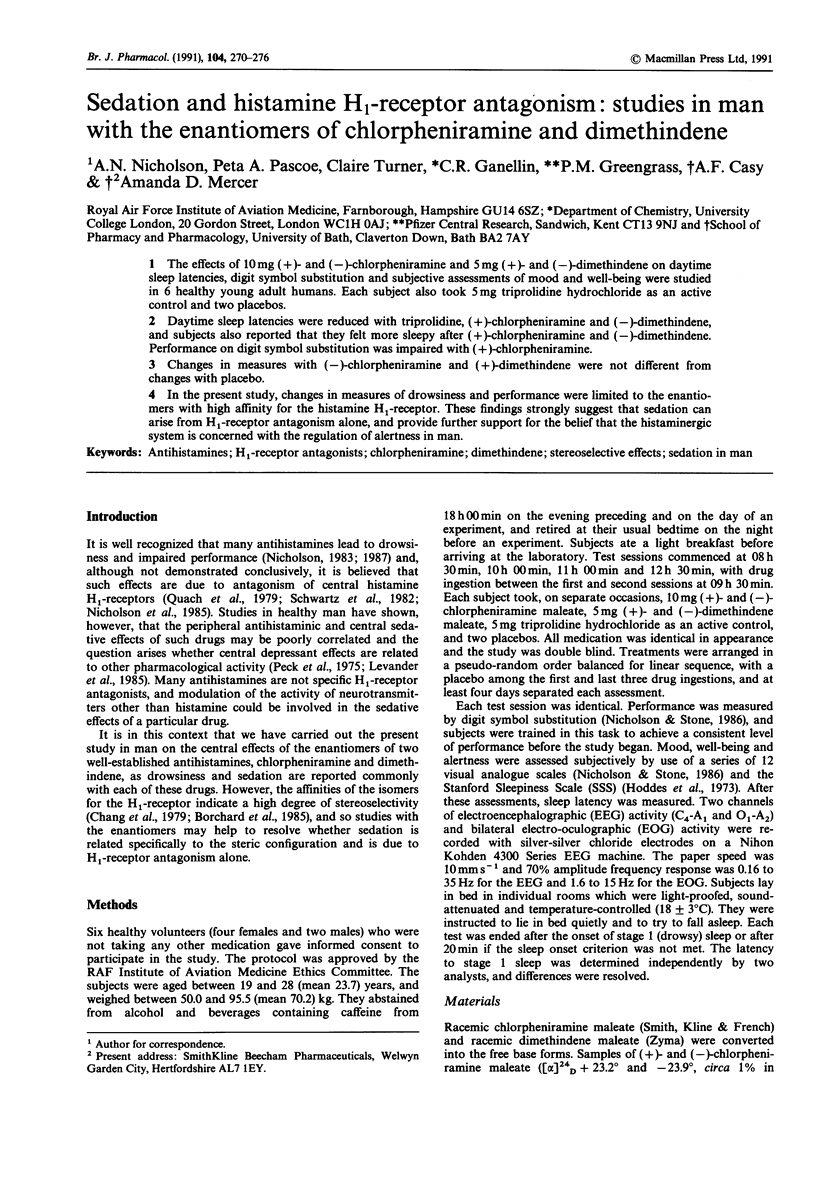
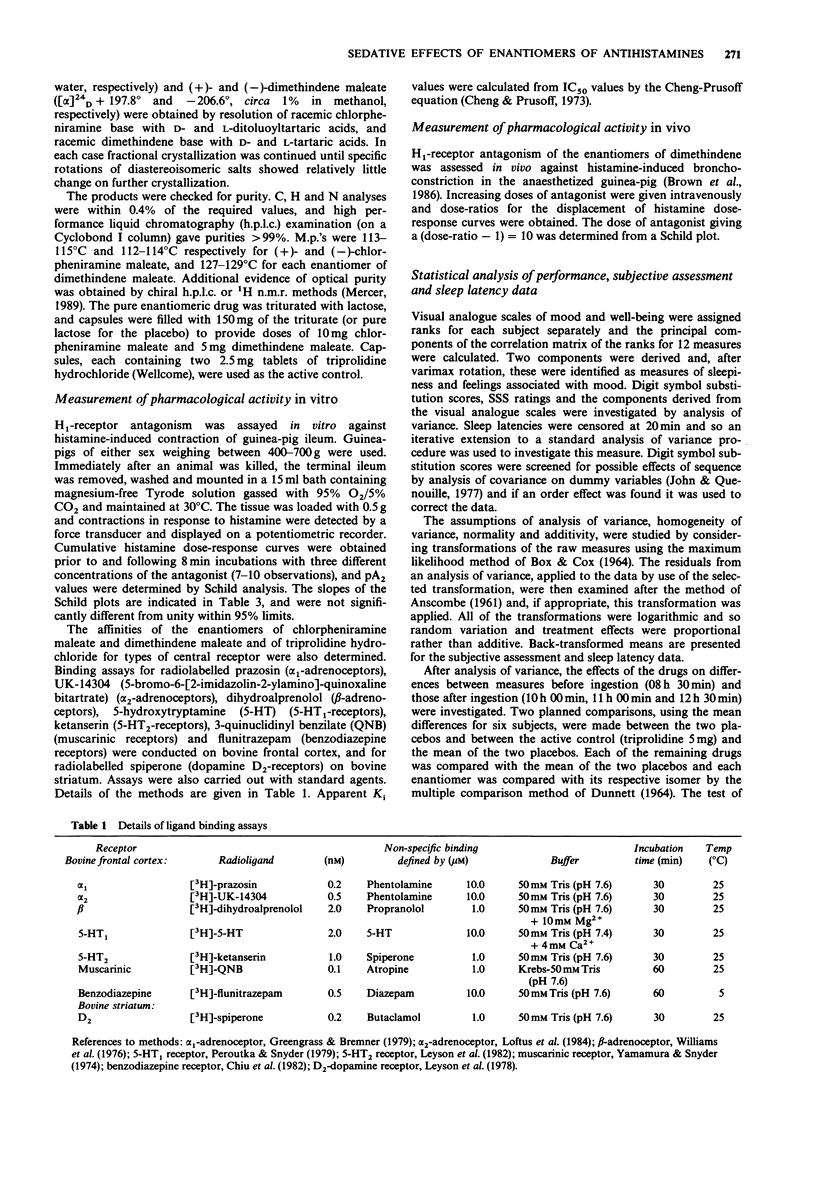
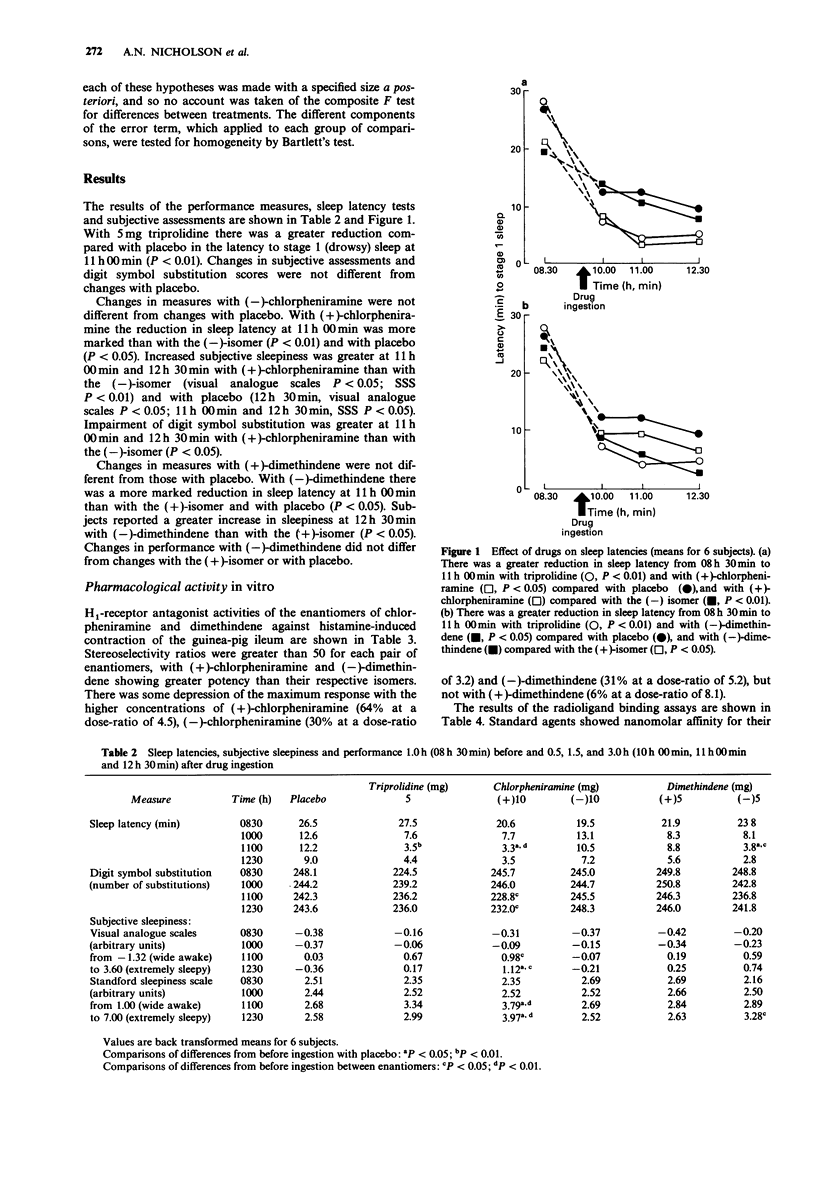
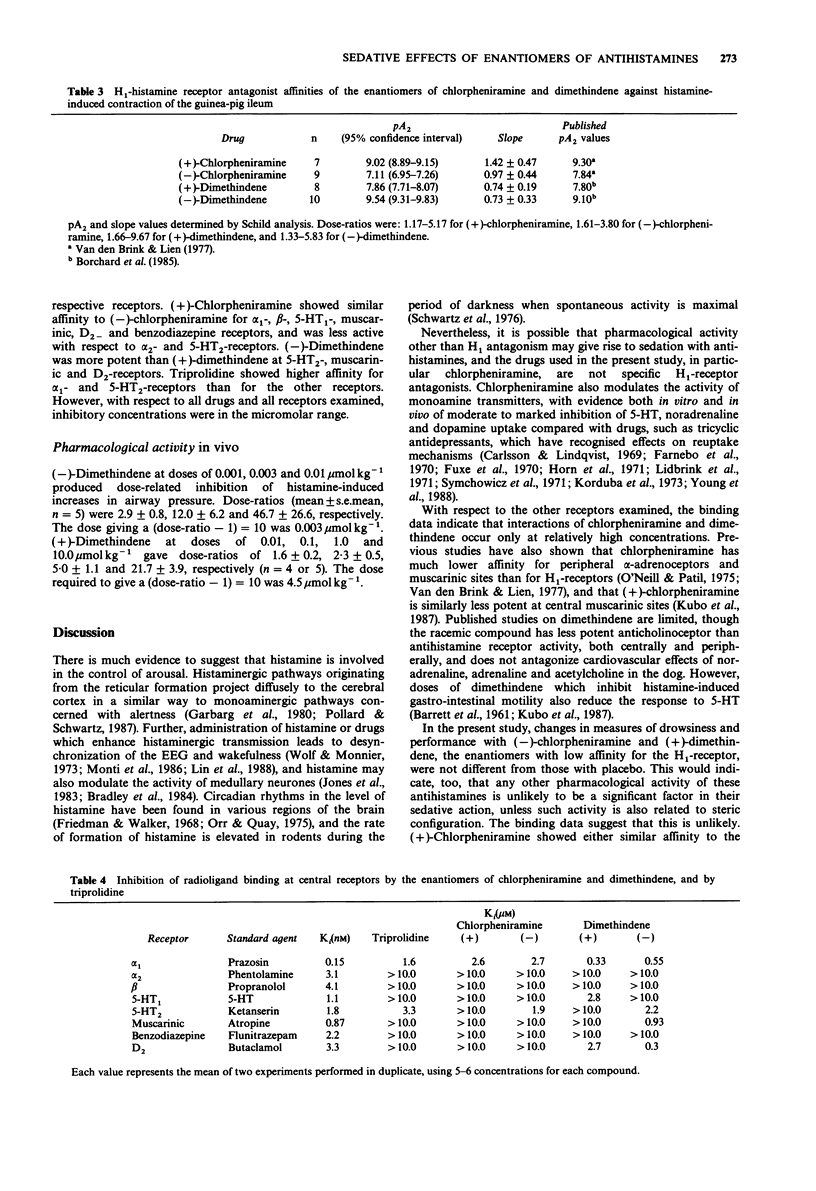
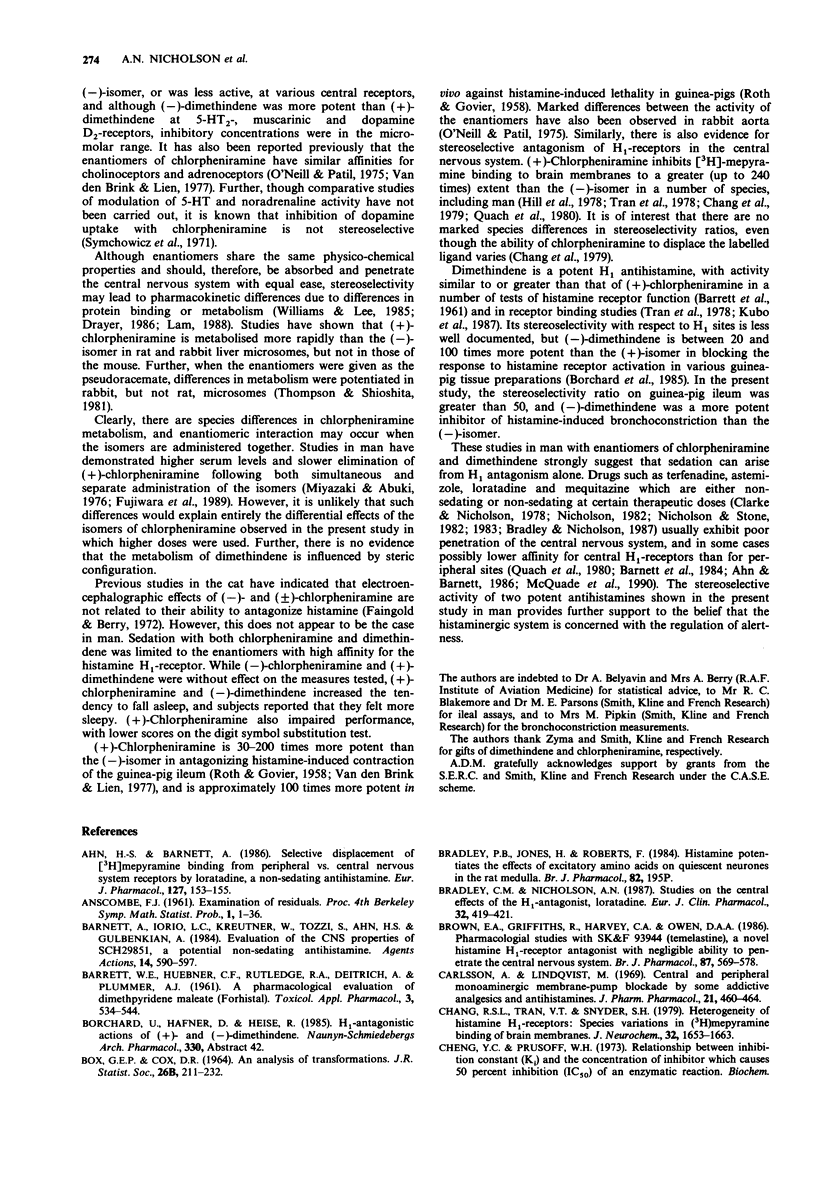
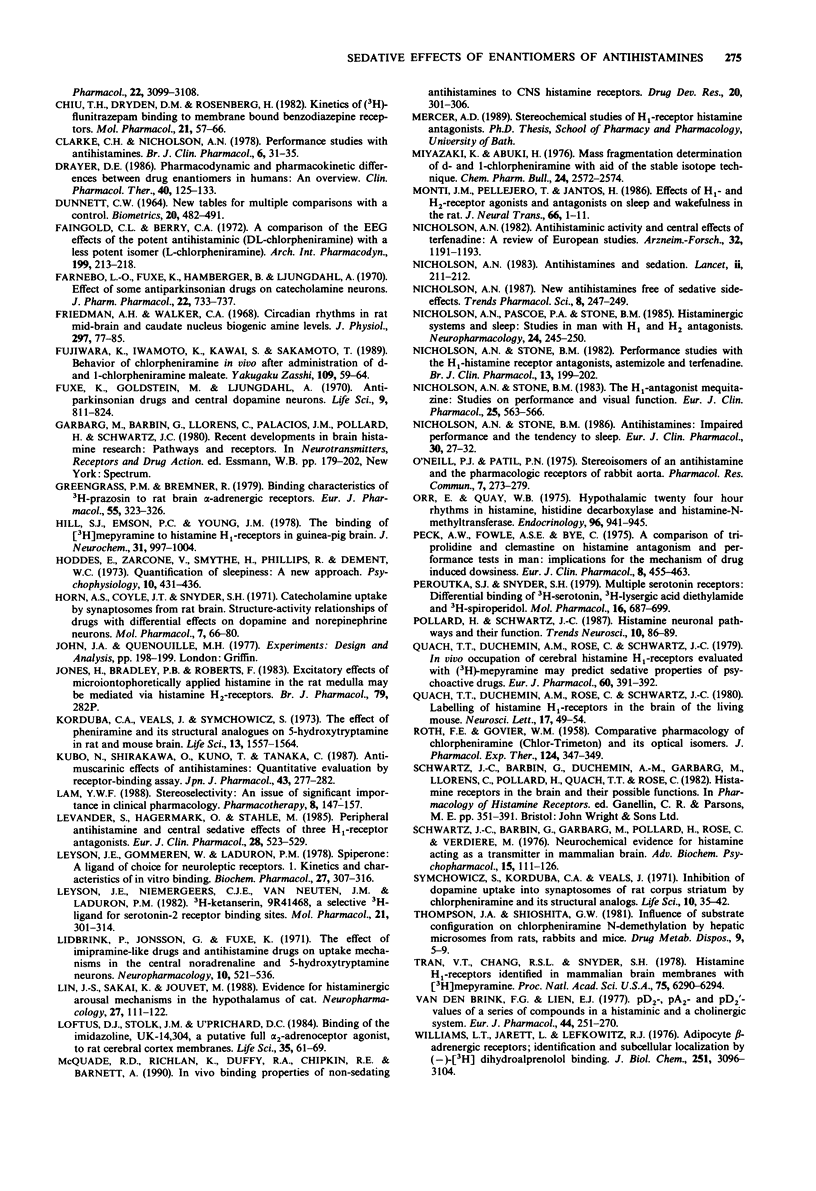
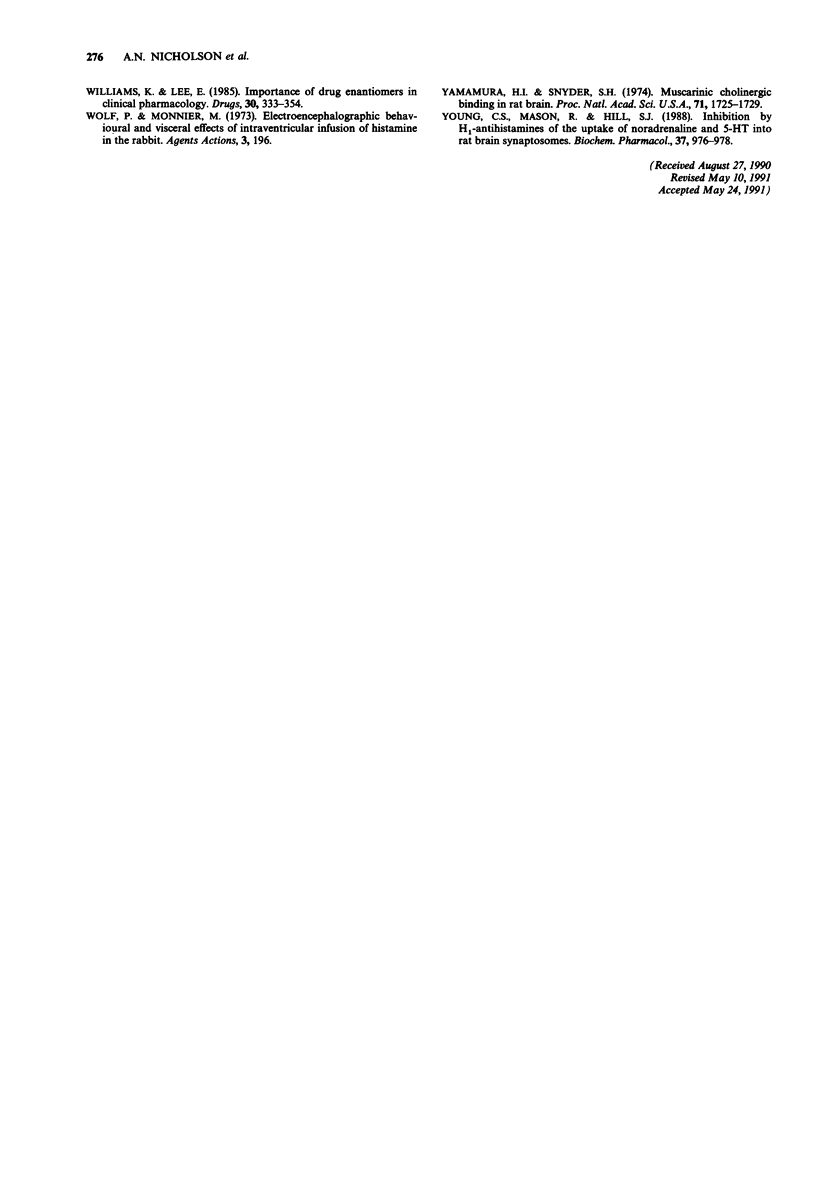
Selected References
These references are in PubMed. This may not be the complete list of references from this article.
- Ahn H. S., Barnett A. Selective displacement of [3H]mepyramine from peripheral vs. central nervous system receptors by loratadine, a non-sedating antihistamine. Eur J Pharmacol. 1986 Aug 7;127(1-2):153–155. doi: 10.1016/0014-2999(86)90219-0. [DOI] [PubMed] [Google Scholar]
- BARRETT W. E., HUEBNER C. F., RUTLEDGE R. A., DEITRICH A., PLUMMER A. J. A pharmacologic investigation of dimethpyrindene maleate (Forhistal). Toxicol Appl Pharmacol. 1961 Sep;3:534–544. doi: 10.1016/0041-008x(61)90044-8. [DOI] [PubMed] [Google Scholar]
- Barnett A., Iorio L. C., Kreutner W., Tozzi S., Ahn H. S., Gulbenkian A. Evaluation of the CNS properties of SCH 29851, a potential non-sedating antihistamine. Agents Actions. 1984 Jun;14(5-6):590–597. doi: 10.1007/BF01978891. [DOI] [PubMed] [Google Scholar]
- Bradley C. M., Nicholson A. N. Studies on the central effects of the H1-antagonist, loratadine. Eur J Clin Pharmacol. 1987;32(4):419–421. doi: 10.1007/BF00543979. [DOI] [PubMed] [Google Scholar]
- Brown E. A., Griffiths R., Harvey C. A., Owen D. A. Pharmacological studies with SK&F 93944 (temelastine), a novel histamine H1-receptor antagonist with negligible ability to penetrate the central nervous system. Br J Pharmacol. 1986 Mar;87(3):569–578. doi: 10.1111/j.1476-5381.1986.tb10199.x. [DOI] [PMC free article] [PubMed] [Google Scholar]
- Carlsson A., Lindqvist M. Central and peripheral monoaminergic membrane-pump blockade by some addictive analgesics and antihistamines. J Pharm Pharmacol. 1969 Jul;21(7):460–464. doi: 10.1111/j.2042-7158.1969.tb08287.x. [DOI] [PubMed] [Google Scholar]
- Chang R. S., Tran V. T., Snyder S. H. Heterogeneity of histamine H1-receptors: species variations in [3H]mepyramine binding of brain membranes. J Neurochem. 1979 Jun;32(6):1653–1663. doi: 10.1111/j.1471-4159.1979.tb02276.x. [DOI] [PubMed] [Google Scholar]
- Chiu T. H., Dryden D. M., Rosenberg H. C. Kinetics of [3H]flunitrazepam binding to membrane-bound benzodiazepine receptors. Mol Pharmacol. 1982 Jan;21(1):57–65. [PubMed] [Google Scholar]
- Clarke C. H., Nicholson A. N. Performance studies with antihistamines. Br J Clin Pharmacol. 1978 Jul;6(1):31–35. doi: 10.1111/j.1365-2125.1978.tb01678.x. [DOI] [PMC free article] [PubMed] [Google Scholar]
- Drayer D. E. Pharmacodynamic and pharmacokinetic differences between drug enantiomers in humans: an overview. Clin Pharmacol Ther. 1986 Aug;40(2):125–133. doi: 10.1038/clpt.1986.150. [DOI] [PubMed] [Google Scholar]
- Faingold C. L., Berry C. A. A comparison of the EEG effects of the potent antihistaminic (DL-chlorpheniramine) with a less potent isomer (L-chlorpheniramine). Arch Int Pharmacodyn Ther. 1972 Oct;199(2):213–218. [PubMed] [Google Scholar]
- Farnebo L. O., Fuxe K., Hamberger B., Ljungdahl H. Effect of some antiparkinsonian drugs on catecholamine neurons. J Pharm Pharmacol. 1970 Oct;22(10):733–737. doi: 10.1111/j.2042-7158.1970.tb08420.x. [DOI] [PubMed] [Google Scholar]
- Friedman A. H., Walker C. A. Circadian rhythms in rat mid-brain and caudate nucleus biogenic amine levels. J Physiol. 1968 Jul;197(1):77–85. doi: 10.1113/jphysiol.1968.sp008547. [DOI] [PMC free article] [PubMed] [Google Scholar]
- Fujiwara K., Iwamoto K., Kawai S., Sakamoto T. [Behavior of chlorpheniramine in vivo after administration of d- and l-chlorpheniramine maleate]. Yakugaku Zasshi. 1989 Jan;109(1):59–64. doi: 10.1248/yakushi1947.109.1_59. [DOI] [PubMed] [Google Scholar]
- Fuxe K., Goldstein M., Ljungdahl A. Antiparkinsonian drugs and central dopamine neurons. Life Sci I. 1970 Jul 15;9(14):811–824. doi: 10.1016/0024-3205(70)90337-1. [DOI] [PubMed] [Google Scholar]
- Greengrass P., Bremner R. Binding characteristics of 3H-prazosin to rat brain alpha-adrenergic receptors. Eur J Pharmacol. 1979 May 1;55(3):323–326. doi: 10.1016/0014-2999(79)90202-4. [DOI] [PubMed] [Google Scholar]
- Hill S. J., Emson P. C., Young J. M. The binding of [3H]mepyramine to histamine H1 receptors in guinea-pig brain. J Neurochem. 1978 Oct;31(4):997–1004. doi: 10.1111/j.1471-4159.1978.tb00139.x. [DOI] [PubMed] [Google Scholar]
- Hoddes E., Zarcone V., Smythe H., Phillips R., Dement W. C. Quantification of sleepiness: a new approach. Psychophysiology. 1973 Jul;10(4):431–436. doi: 10.1111/j.1469-8986.1973.tb00801.x. [DOI] [PubMed] [Google Scholar]
- Horn A. S., Coyle J. T., Snyder S. H. Catecholamine uptake by synaptosomes from rat brain. Structure-activity relationships of drugs with differential effects on dopamine and norepinephrine neurons. Mol Pharmacol. 1971 Jan;7(1):66–80. [PubMed] [Google Scholar]
- Korduba C. A., Veals J., Symchowicz S. The effect of pheniramine and its structural analogues on 5-hydroxytryptamine in rat and mouse brain. Life Sci. 1973 Dec 1;13(11):1557–1564. doi: 10.1016/0024-3205(73)90144-6. [DOI] [PubMed] [Google Scholar]
- Kubo N., Shirakawa O., Kuno T., Tanaka C. Antimuscarinic effects of antihistamines: quantitative evaluation by receptor-binding assay. Jpn J Pharmacol. 1987 Mar;43(3):277–282. doi: 10.1254/jjp.43.277. [DOI] [PubMed] [Google Scholar]
- Lam Y. W. Stereoselectivity: an issue of significant importance in clinical pharmacology. Pharmacotherapy. 1988;8(3):147–157. doi: 10.1002/j.1875-9114.1988.tb04069.x. [DOI] [PubMed] [Google Scholar]
- Levander S., Hägermark O., Ståhle M. Peripheral antihistamine and central sedative effects of three H1-receptor antagonists. Eur J Clin Pharmacol. 1985;28(5):523–529. doi: 10.1007/BF00544062. [DOI] [PubMed] [Google Scholar]
- Leysen J. E., Gommeren W., Laduron P. M. Spiperone: a ligand of choice for neuroleptic receptors. 1. Kinetics and characteristics of in vitro binding. Biochem Pharmacol. 1978 Feb 1;27(3):307–316. doi: 10.1016/0006-2952(78)90233-2. [DOI] [PubMed] [Google Scholar]
- Leysen J. E., Niemegeers C. J., Van Nueten J. M., Laduron P. M. [3H]Ketanserin (R 41 468), a selective 3H-ligand for serotonin2 receptor binding sites. Binding properties, brain distribution, and functional role. Mol Pharmacol. 1982 Mar;21(2):301–314. [PubMed] [Google Scholar]
- Lidbrink P., Jonsson G., Fuxe K. The effect of imipramine-like drugs and antihistamine drugs on uptake mechanisms in the central noradrenaline and 5-hydroxytryptamine neurons. Neuropharmacology. 1971 Sep;10(5):521–536. doi: 10.1016/0028-3908(71)90018-9. [DOI] [PubMed] [Google Scholar]
- Lin J. S., Sakai K., Jouvet M. Evidence for histaminergic arousal mechanisms in the hypothalamus of cat. Neuropharmacology. 1988 Feb;27(2):111–122. doi: 10.1016/0028-3908(88)90159-1. [DOI] [PubMed] [Google Scholar]
- Loftus D. J., Stolk J. M., U'Prichard D. C. Binding of the imidazoline UK-14, 304, a putative full alpha 2-adrenoceptor agonist, to rat cerebral cortex membranes. Life Sci. 1984 Jul 2;35(1):61–69. doi: 10.1016/0024-3205(84)90152-8. [DOI] [PubMed] [Google Scholar]
- Miyazaki H., Abuki H. Mass fragmentographic determination of d- and l-chloropheniramine with aid of the stable isotope technique. Chem Pharm Bull (Tokyo) 1976 Oct;24(10):2572–2574. doi: 10.1248/cpb.24.2572. [DOI] [PubMed] [Google Scholar]
- Monti J. M., Pellejero T., Jantos H. Effects of H1- and H2-histamine receptor agonists and antagonists on sleep and wakefulness in the rat. J Neural Transm. 1986;66(1):1–11. doi: 10.1007/BF01262953. [DOI] [PubMed] [Google Scholar]
- Nicholson A. N. Antihistaminic activity and central effects of terfenadine. A review of European studies. Arzneimittelforschung. 1982;32(9A):1191–1193. [PubMed] [Google Scholar]
- Nicholson A. N., Pascoe P. A., Stone B. M. Histaminergic systems and sleep. Studies in man with H1 and H2 antagonists. Neuropharmacology. 1985 Mar;24(3):245–250. doi: 10.1016/0028-3908(85)90081-4. [DOI] [PubMed] [Google Scholar]
- Nicholson A. N., Stone B. M. Antihistamines: impaired performance and the tendency to sleep. Eur J Clin Pharmacol. 1986;30(1):27–32. doi: 10.1007/BF00614191. [DOI] [PubMed] [Google Scholar]
- Nicholson A. N., Stone B. M. Performance studies with the H1-histamine receptor antagonists, astemizole and terfenadine. Br J Clin Pharmacol. 1982 Feb;13(2):199–202. doi: 10.1111/j.1365-2125.1982.tb01356.x. [DOI] [PMC free article] [PubMed] [Google Scholar]
- Nicholson A. N., Stone B. M. The H1-antagonist mequitazine: studies on performance and visual function. Eur J Clin Pharmacol. 1983;25(4):563–566. doi: 10.1007/BF00542129. [DOI] [PubMed] [Google Scholar]
- O'Neill P. J., Patil P. N. Stereoisomers of an antihistamine and the pharmacologic receptors of rabbit aorta. Pharmacol Res Commun. 1975 Jun;7(3):273–279. doi: 10.1016/0031-6989(75)90026-0. [DOI] [PubMed] [Google Scholar]
- Orr E., Quay W. B. Hypothalamic 24-hour rhythms in histamine, histidine, decarboxylase and histamine-N-methyltransferase. Endocrinology. 1975 Apr;96(4):941–945. doi: 10.1210/endo-96-4-941. [DOI] [PubMed] [Google Scholar]
- Peck A. W., Fowle A. S., Bye C. A comparison of triprolidine and clemastine on histamine antagonism and performance tests in man: implications for the mechanism of drug induced drowsiness. Eur J Clin Pharmacol. 1975 Aug 14;8(6):455–463. doi: 10.1007/BF00562321. [DOI] [PubMed] [Google Scholar]
- Peroutka S. J., Snyder S. H. Multiple serotonin receptors: differential binding of [3H]5-hydroxytryptamine, [3H]lysergic acid diethylamide and [3H]spiroperidol. Mol Pharmacol. 1979 Nov;16(3):687–699. [PubMed] [Google Scholar]
- Quach T. T., Duchemin A. M., Rose C., Schwartz J. C. In vivo occupation of cerebral histamine H1-receptors evaluated with 3H-mepyramine may predict sedative properties of psychotropic drugs. Eur J Pharmacol. 1979 Dec 20;60(4):391–392. doi: 10.1016/0014-2999(79)90250-4. [DOI] [PubMed] [Google Scholar]
- Quach T. T., Duchemin A. M., Rose C., Schwartz J. C. Labeling of histamine H1-receptors in the brain of the living mouse. Neurosci Lett. 1980 Apr;17(1-2):49–54. doi: 10.1016/0304-3940(80)90060-9. [DOI] [PubMed] [Google Scholar]
- ROTH F. E., GOVIER W. M. Comparative pharmacology of chlorpheniramine (Chlor-Trimeton) and its optical isomers. J Pharmacol Exp Ther. 1958 Dec;124(4):347–349. [PubMed] [Google Scholar]
- Schwartz J. C., Barbin G., Garbarg B. M., Pollard H., Rose C., Verdiere M. Neurochemical evidence for histamine acting as a transmitter in mammalian brain. Adv Biochem Psychopharmacol. 1976;15:111–126. [PubMed] [Google Scholar]
- Symchowicz S., Korduba C. A., Veals J. Inhibition of dopamine uptake into synaptosomes of rat corpus striatum by chlorpheniramine and its structural analogs. Life Sci I. 1971 Jan 1;10(1):35–42. doi: 10.1016/0024-3205(71)90243-8. [DOI] [PubMed] [Google Scholar]
- Thompson J. A., Shioshita G. W. Influence of substrate configuration on chlorpheniramine N-demethylation by hepatic microsomes from rats, rabbits, and mice. Drug Metab Dispos. 1981 Jan-Feb;9(1):5–9. [PubMed] [Google Scholar]
- Tran V. T., Chang R. S., Snyder S. H. Histamine H1 receptors identified in mammalian brain membranes with [3H]mepyramine. Proc Natl Acad Sci U S A. 1978 Dec;75(12):6290–6294. doi: 10.1073/pnas.75.12.6290. [DOI] [PMC free article] [PubMed] [Google Scholar]
- Williams K., Lee E. Importance of drug enantiomers in clinical pharmacology. Drugs. 1985 Oct;30(4):333–354. doi: 10.2165/00003495-198530040-00003. [DOI] [PubMed] [Google Scholar]
- Williams L. T., Jarett L., Lefkowitz R. J. Adipocyte beta-adrenergic receptors. Identification and subcellular localization by (-)-[3H]dihydroalprenolol binding. J Biol Chem. 1976 May 25;251(10):3096–3104. [PubMed] [Google Scholar]
- Wolf P., Monnier M. Electroencephalographic, behavioural and visceral effects of intraventricular infusion of histamine in the rabbit. Agents Actions. 1973 Oct;3(3):196–196. doi: 10.1007/BF01965754. [DOI] [PubMed] [Google Scholar]
- Yamamura H. I., Snyder S. H. Muscarinic cholinergic binding in rat brain. Proc Natl Acad Sci U S A. 1974 May;71(5):1725–1729. doi: 10.1073/pnas.71.5.1725. [DOI] [PMC free article] [PubMed] [Google Scholar]
- Young C. S., Mason R., Hill S. J. Inhibition by H1-antihistamines of the uptake of noradrenaline and 5-HT into rat brain synaptosomes. Biochem Pharmacol. 1988 Mar 1;37(5):976–978. doi: 10.1016/0006-2952(88)90194-3. [DOI] [PubMed] [Google Scholar]
- van den Brink F. G., Lien E. J. pD2-, pA2- and pD2'-values of a series of compounds in a histaminic and a cholinergic system. Eur J Pharmacol. 1977 Aug 1;44(3):251–270. doi: 10.1016/0014-2999(77)90072-3. [DOI] [PubMed] [Google Scholar]


